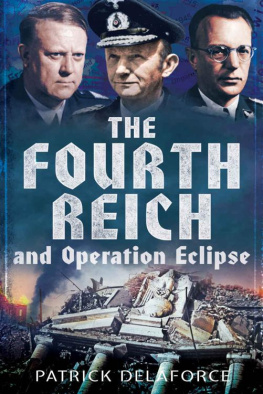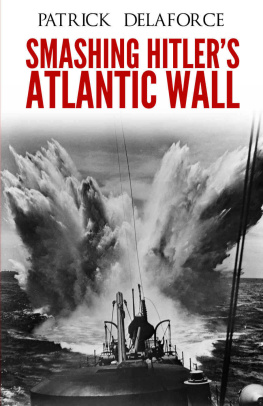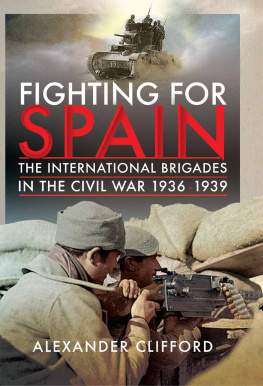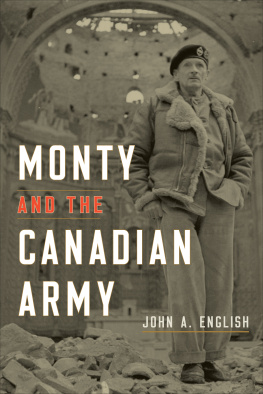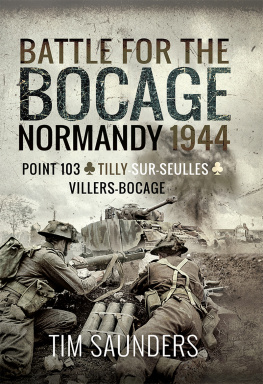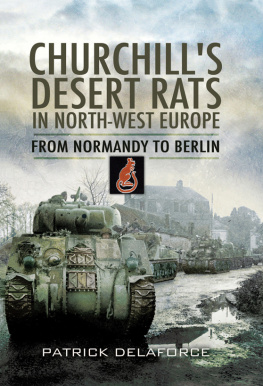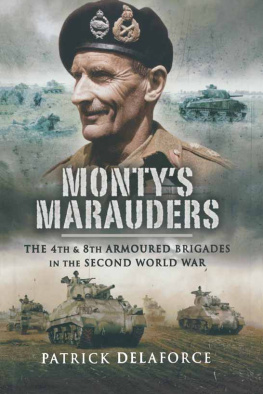First published in Great Britain in 1993 by Donovan Publishing Ltd
Reprinted in 2000 by Octopus Publishing Group Ltd
Published in this format in 2008 by
PEN & SWORD MILITARY
an imprint of
Pen & Sword Books Ltd
47 Church Street
Barnsley
South Yorkshire
S70 2AS
Copyright Patrick Delaforce, 1993, 2000, 2008
ISBN 978 1 84415 630 6
The right of Patrick Delaforce to be identified as Author
of this work has been asserted by him in accordance
with the Copyright, Designs and Patents Act 1988.
A CIP catalogue record for this book is
available from the British Library.
All rights reserved. No part of this book may be reproduced
or transmitted in any form or by any means, electronic or mechanical
including photocopying,
recording or by any information storage
and retrieval system, without permission
from the Publisher in writing.
Printed and bound in Great Britain
By Biddles
Pen & Sword Books Ltd incorporates the imprints of:
Pen & Sword Aviation, Pen & Sword Maritime, Pen & Sword Military,
Wharncliffe Local History, Pen & Sword Select,
Pen & Sword Military Classics and Leo Cooper.
For a complete list of Pen & Sword titles please contact:
PEN & SWORD BOOKS LIMITED
47 Church Street, Barnsley, South Yorkshire, S70 2AS, England
E-mail: enquiries@pen-and-sword.co.uk
Website: www.pen-and-sword.co.uk
1
Early History
T his is the story of a famous armoured brigade who fought almost nonstop throughout World War II. In the process they lost thousands of casualties and several times in the desert war their tank forces were almost wiped out.
After the Munich crisis in the Autumn of 1938, the then Mobile Division (Egypt) a hotchpotch of arms and units was later renamed in January 1940 and became perhaps the best-known division of the 20th Century the 7th Armoured Division, the Desert Rats of North Africa. It was Major General Creaghs wife, who inspecting a little desert rodent in the Cairo Zoo, called a Jerboa, suggested the tough little leaping rat as an appropriate divisional insignia! And 4th Armoured Brigade, part of 7th Armoured Division for two years, shared (almost) the same insignia. Field Marshal Lord Michael Carver, then a young RTR subaltern recalled,
The Cairo Cavalry Brigade [part of the MDE], consisted of the 7th Hussars in light tanks, the 8th Hussars in Ford 15-cwt pick-up trucks on which were mounted Vickers-Berthier heavy MGs, the 11th Hussars with their old Rolls Royce armoured cars and 1st Royal Tanks with light tanks. The ancient Vickers medium Mark Is and IIs of 6 RTR were left in Cairo, their role being that of internal security. Third Royal Horse Artillery [later the authors regiment] had short range 3.7 howitzers, and the infantry were 1st Bn KRRC (60th Rifles).
Little did the wearers of the Desert Rat insignia realise that nearly six years later, after many victories, and some defeats, they would be parading in the centre of Berlin before the Prime Minister, Winston Churchill and all his attendant Field Marshals and Generals.
Brigadier JAL Caunter DSO, MC was the first brigadier. His nickname was Blood, since buckets of blood was his favourite exhortation. He commanded the 6th RTR and 7th Hussars in barracks at Abbassia, equipped with MkIV and some A-9 medium tanks. There were not enough 2-pdr guns or tank MGs to go round and when the GOC, General Jumbo Wilson held an exercise in February 1940 all the brand new A-9 tanks seized up!
To the immediate west of Cairo, there were only two roads in the whole area, the coast road and a secondary one running from Matruh southward to the Siwa Oasis. The coast road was tarmac from Matruh, the rail-head, and along the 70 mile stretch to Sidi Barrani. The next 60 miles to the frontier near Sollum was little better than a track. But on the Italian side of the frontier was a good tarmac road. The outstanding desert feature was the steep escarpment which is parallel to the coast in Cyrenaica, and from Sollum it slants south-east and the notorious Halfaya Pass (Hellfire Pass, naturally), a series of hairpin bends is four miles south-east of Sollum. The Italians had covered their Libyan frontier with a barbed wire fence -known as the Wire twelve feet deep and five feet high, running inland for an amazing 400 miles!
When France fell in the Spring/Summer of 1940 the opportunistic Italian forces entered the war and by mid-June Mussolini had already built up his army strength in Africa. Marshal Balbo hurried his western army from Tunis (the French had surrendered the strong Mareth line defences) and up to the Egyptian border. So General Wavell ordered General Jumbo Wilson to make a bold sortie along the coast road to Sidi Barrani and Mersa Matruh. It was a bold game of bluff to convince the enemy that the British (Empire) Army of 36,000 (including New Zealanders and Indian units) was much stronger than it actually was. There were half a dozen Italian divisions across the border and many small violent British raids were made.
From Gerawli, the 4th Armoured Brigade with their sister brigade, 7th Armoured, moved west to the escarpment south-east of Halfaya Pass to attack Fort Capuzzo. Shades of Beau Geste! It was the typical desert post, valuable for keeping the Arab tribesmen at bay; it had four stone walls with crenellated battlements enclosing a central courtyard. The Cherry Pickers (11th Hussars) with 4 RHA captured Fort Maddalena some 60 miles inland. On 14 June 7th Hussars light MkVI tanks, supported by D Coy KRRC and I Bty RHA assaulted Fort Capuzzo backed by naval gunfire and RAF support. They killed or captured the wretched garrison. Captain HR Woods was OC the Carrier Platoon 1st Bn KRRC: The 11th Hussars told us the garrison of Fort Capuzzo was about 300 Libyans plus some white [Italian] troops. There were MGs mounted on the white walls of the fort, dimensions about 200 yards by 100 yards. D Coy were to follow in trucks close on the tanks as they cleared the way for us. We would then de-truck under the walls of the fort, break in with all possible speed and capture the garrison. Four RAF Blenheims bombed the fort. The attack went like clockwork. Three gates were found, out of which Libyans in every variety of garment continued to pour out, very frightened, throwing down arms, grenades, equipment and clothing. A booby-trapped 2-ton Italian water lorry blew up but caused no casualties. 200 POW including three officers were taken; in the distance could be seen two riflemen sampling Chianti for the first time! The prisoners were sent to Sollum guarded by the Rhodesian platoon. Three waves of Italian bombers dropped 200 bombs and the unfortunate prisoners lost 24 casualties. The battalion then spent the next six months in the Sollum area, 430 miles from Cairo, engaged in fighting patrols despite the Italian airforce and efficient artillery shelling of Sollum barracks.
Sgt Roberts 7th Hussars was there: After the declaration of war by the Italians, 7th Hussars crossed the Libyan wire and attacked Fort Capuzzo. The first tank attack of the Desert War. We lost one tank blown up on a mine and the driver was killed. Two days later: A Sqn intercepted a convoy of lorried infantry supported by Italian tanks. A Sqn A-9 cruisers knocked-out the Italian tanks. The first tank battle in the desert. The regiments who formed the original 7th Armoured Div were the 7th, 8th and 11th Hussars. In the second engagement a dozen M-13 Italian tanks were knocked-out and an entire battalion taken prisoner. By June 1940 the casual style of desert dress had arrived, later made famous by JONs Two types. Suede desert boots (often described as brothel creepers), light corduroy trousers (coloured green, pink, etc) a coloured silk neckerchief or scarf. Fly whisks were optional and in cold weather, Persian goatskin coats were sported!


